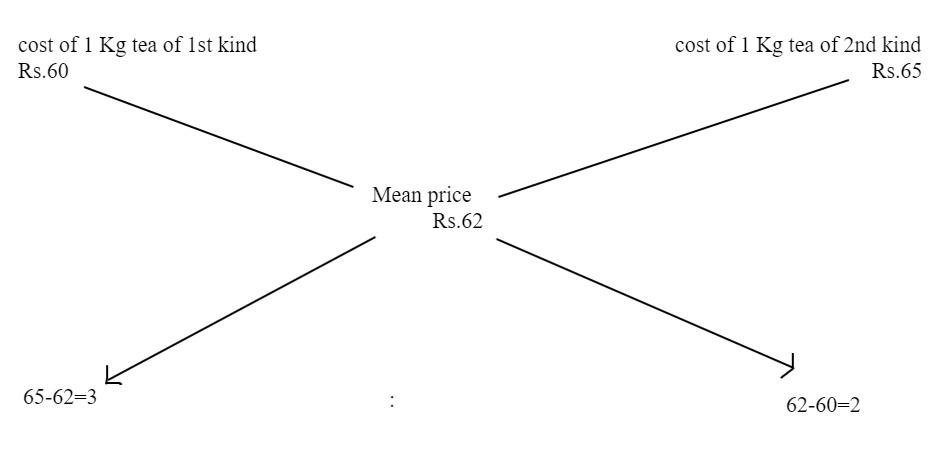
In what ratio must a grocer mix two varieties of tea worth Rs 60 per kg and Rs 65 per kg so that by selling the mixture at Rs 68.20 a kg he may gain 10%?
A. \[3:2\]
B. \[3:4\]
C. \[3:5\]
D. \[4:5\]
Answer
609k+ views
Hint: Here Percentage gain means to express the profit or the gain in the form of percentages. And remind that the price paid by the retailer for the goods that he is going to sell is called the cost price and the price at which he is selling that goods to the consumers is called the selling price.
Complete step-by-step answer:
Given Selling price (SP) of 1 kg of the mixture = Rs 68.20
Percentage of profit or gain = 10%
We know that cost price \[CP = \dfrac{{SP \times 100}}{{100 + Gain\% }}\]
\[
CP = \dfrac{{68.20 \times 100}}{{100 + 10}} \\
\\
CP = \dfrac{{6820}}{{110}} \\
\\
\therefore CP = Rs{\text{ }}62 \\
\]
Given cost of 1 kg tea of first kind = Rs 60
Cost of 1 kg tea of second kind = Rs 65
So, the mean price \[ = \dfrac{{60 + 65}}{2} = 62.50 \cong R{\text{s 62}}\]
By the rule of allegation, we have

Therefore, the required ratio is \[3:2\]
Thus, the correct option is A. \[3:2\].
Note: In this problem we have used the rule of allegation. The rule of allegation states that “when different quantities of different ingredients are mixed together to produce a mixture of a mean value, the ratio of their quantities is inversely proportional to the differences in their cast from the mean value”.
Complete step-by-step answer:
Given Selling price (SP) of 1 kg of the mixture = Rs 68.20
Percentage of profit or gain = 10%
We know that cost price \[CP = \dfrac{{SP \times 100}}{{100 + Gain\% }}\]
\[
CP = \dfrac{{68.20 \times 100}}{{100 + 10}} \\
\\
CP = \dfrac{{6820}}{{110}} \\
\\
\therefore CP = Rs{\text{ }}62 \\
\]
Given cost of 1 kg tea of first kind = Rs 60
Cost of 1 kg tea of second kind = Rs 65
So, the mean price \[ = \dfrac{{60 + 65}}{2} = 62.50 \cong R{\text{s 62}}\]
By the rule of allegation, we have

Therefore, the required ratio is \[3:2\]
Thus, the correct option is A. \[3:2\].
Note: In this problem we have used the rule of allegation. The rule of allegation states that “when different quantities of different ingredients are mixed together to produce a mixture of a mean value, the ratio of their quantities is inversely proportional to the differences in their cast from the mean value”.
Recently Updated Pages
Master Class 12 Business Studies: Engaging Questions & Answers for Success

Master Class 12 Economics: Engaging Questions & Answers for Success

Master Class 12 English: Engaging Questions & Answers for Success

Master Class 12 Maths: Engaging Questions & Answers for Success

Master Class 12 Social Science: Engaging Questions & Answers for Success

Master Class 12 Chemistry: Engaging Questions & Answers for Success

Trending doubts
What is BLO What is the full form of BLO class 8 social science CBSE

Citizens of India can vote at the age of A 18 years class 8 social science CBSE

Name the states through which the Tropic of Cancer class 8 social science CBSE

Full form of STD, ISD and PCO

Right to vote is a AFundamental Right BFundamental class 8 social science CBSE

Summary of the poem Where the Mind is Without Fear class 8 english CBSE




